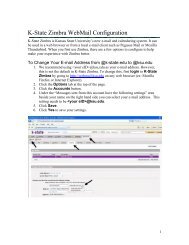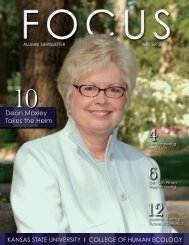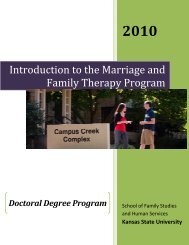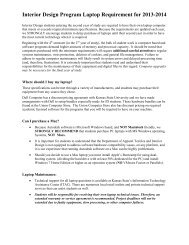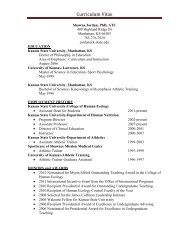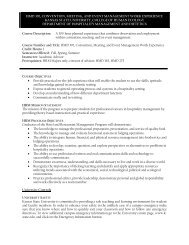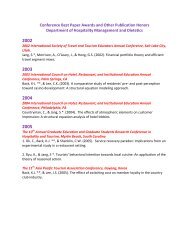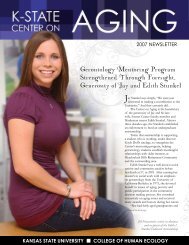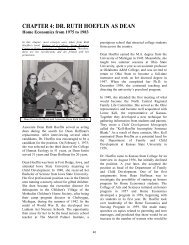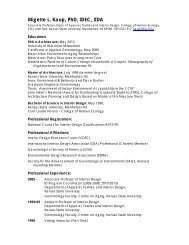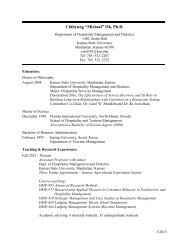Spring 2013 - College of Human Ecology - Kansas State University
Spring 2013 - College of Human Ecology - Kansas State University
Spring 2013 - College of Human Ecology - Kansas State University
You also want an ePaper? Increase the reach of your titles
YUMPU automatically turns print PDFs into web optimized ePapers that Google loves.
Past<br />
Are you smarter than an 1877 student<br />
The Catalogue <strong>of</strong> the <strong>Kansas</strong> <strong>State</strong> Agricultural <strong>College</strong> <strong>of</strong> 1877-78 instructs<br />
students on expenses (“Tuition is free, and no charges are made for incidental<br />
or ‘contingent’ expenses”), on faculty names and titles (There were 12, counting<br />
President George T. Fairchild, pr<strong>of</strong>essor <strong>of</strong> political economy), and on courses <strong>of</strong><br />
study (Offerings for first-year, second-year, third-year and fourth-year students<br />
were divided in to three terms — fall, winter and spring).<br />
On page 32 the booklet addresses admission: “Candidates for admission<br />
… must be at least fourteen years <strong>of</strong> age, and able to pass a satisfactory<br />
examination in reading, spelling, writing, arithmetic to percentage, geography<br />
and elements <strong>of</strong> English grammar.”<br />
Then it gives some sample arithmetic questions. No calculators were allowed.<br />
The catalog did not give the answers so we asked Robert B. Burckel, pr<strong>of</strong>essor <strong>of</strong><br />
mathematics, for some help. We thank Dr. Burckel for his answers and annotations.<br />
en President John A. Anderson<br />
, in doing so, introduced home<br />
llege was the pioneer school in<br />
erienced several name changes:<br />
en’s course/Domestic economy<br />
ewing and Household Economy<br />
epartment <strong>of</strong> Domestic Science<br />
12 Division <strong>of</strong> Home Economics<br />
942 School <strong>of</strong> Home Economics<br />
63 <strong>College</strong> <strong>of</strong> Home Economics<br />
985 <strong>College</strong> <strong>of</strong> <strong>Human</strong> <strong>Ecology</strong><br />
...<br />
How many barrels, each holding 2 bushels and 3 pecks, will be<br />
needed to contain 880 bushels <strong>of</strong> apples<br />
... Probably it was not an issue with farm kids in 1877, but no student<br />
(or adult) today could relate pecks to bushels. A dictionary informs us<br />
that a bushel is 4 pecks, so the problem is telling us that a barrel holds<br />
2 + ¾ = 11 ⁄4 bushels. Thus one wants to know how many times this<br />
number is present in 880; that is, one divides 880 by 11 ⁄4 (equivalently,<br />
one multiplies 880 by 4 ⁄11). Of course, a fractional answer will have to<br />
be rounded upward, as there are no fractional barrels.<br />
...<br />
...<br />
Add 3 ⁄5, 4 ⁄7, 13 ⁄21, and 7 ⁄15.<br />
For a bunch <strong>of</strong> dimes and quarters one only needs a common unit<br />
<strong>of</strong> currency, nickels. Here a common unit is 1 ⁄105 (105 = 3 times 5<br />
times 7): 3 ⁄5 = 63 ⁄105, 4 ⁄7 = 60 ⁄105, 13 ⁄21 = 65 ⁄105, 7 ⁄15 = 49 ⁄105. Altogether<br />
there are 63 + 60 + 65 + 49 = 237 <strong>of</strong> these 1 ⁄105 ‘s. That is, 237 ⁄105 (=<br />
79⁄35 in ‘lowest terms’, if you prefer).<br />
...<br />
How many cords in a pile <strong>of</strong> four-foot wood, five feet six inches high<br />
and twenty-three feet long<br />
... Today only tradesmen know the definition <strong>of</strong> “cord,” so the present<br />
wording is hardly suitable for 21st-century students. A dictionary<br />
clarifies that a cord is 128 cubic feet. The given volume <strong>of</strong> wood is<br />
(4 feet) times (5.5 feet) times (23 feet) = 506 cubic feet. Each 128<br />
cubic feet <strong>of</strong> this is 1 cord, so you’re simply being asked how many<br />
128’s there are in 506.<br />
...<br />
If by selling cloth at $0.75 a yard I gain 18 ¾ percent on the cost,<br />
how much must I advance up on this price to gain 31¼ percent on<br />
the cost (From the 1882-82 catalogue)<br />
... If the problem is saying that a price <strong>of</strong> 75 earns 18 percent pr<strong>of</strong>it and<br />
wants to know what price will earn 31 percent pr<strong>of</strong>it, we can proceed<br />
as follows: The “given” is that 75 = cost + pr<strong>of</strong>it = cost + 18 percent<br />
<strong>of</strong> cost = cost + .18 cost = 1.18 cost. Therefore, cost = 75 ⁄1.18. To<br />
earn 31 percent pr<strong>of</strong>it on this cost means we must charge cost + 31<br />
percent cost = cost + .31 cost = 1.31 cost = 1.31 times 75 ⁄1.18. You can<br />
do this arithmetic. (Of course, the unit <strong>of</strong> cost is cents-per-yard.)<br />
7





